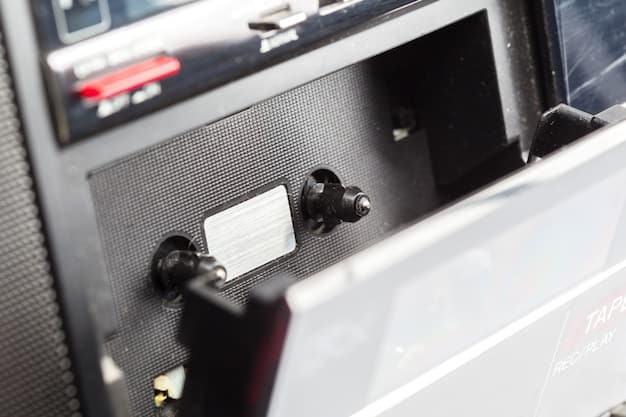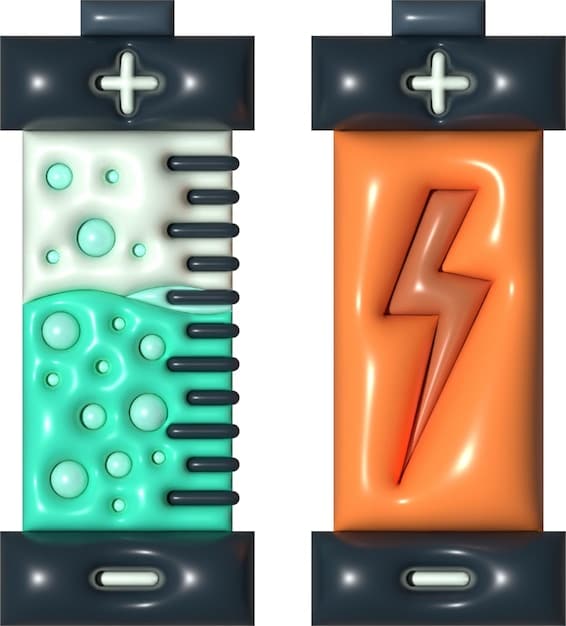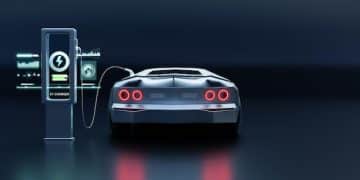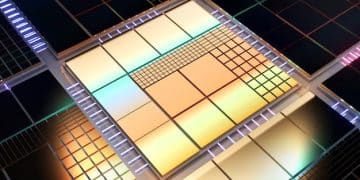Solid-State Batteries in US EVs: Real-World Performance Review

Solid-state batteries promise enhanced energy density and safety for electric vehicles, but their real-world performance in US EVs is still under evaluation, with factors like temperature sensitivity and manufacturing scalability impacting their overall effectiveness.
The automotive industry is abuzz with talk about what’s the real-world performance of new solid-state batteries in US electric vehicles. Promising higher energy density, faster charging, and improved safety compared to traditional lithium-ion batteries, solid-state technology is poised to revolutionize the EV landscape. But how do these next-generation batteries actually perform on US roads?
Understanding Solid-State Battery Technology
Solid-state batteries represent a significant leap forward in battery technology. Unlike conventional lithium-ion batteries that use a liquid electrolyte, solid-state batteries utilize a solid electrolyte. This fundamental difference unlocks a range of potential advantages.
The key to understanding solid-state batteries lies in their construction and the materials they employ. The solid electrolyte is the star of the show, replacing the flammable liquid found in lithium-ion batteries.
Key Components of a Solid-State Battery
While the specific materials can vary, the general structure of a solid-state battery consists of:
- Cathode: The positive electrode, often made from materials like lithium cobalt oxide (LCO) or nickel manganese cobalt oxide (NMC).
- Anode: The negative electrode, which can be lithium metal or other advanced materials.
- Solid Electrolyte: The key innovation, replacing the liquid electrolyte with a solid ceramic, glass, or polymer material.
- Current Collectors: Conductive materials that facilitate the flow of electrons.

The use of a solid electrolyte offers several potential benefits, including increased energy density, enhanced safety, and the possibility of using lithium metal anodes. This translates to longer driving ranges, faster charging times, and a reduced risk of fire.
Potential Advantages of Solid-State Batteries in EVs
The shift to solid-state batteries brings with it a wave of anticipated benefits for electric vehicles. These advantages stem from the unique properties of the solid electrolyte and the design possibilities it unlocks.
From enhanced energy density to improved safety, solid-state batteries have the potential to address some of the key limitations of current EV technology.
Increased Energy Density and Range
Solid-state batteries can potentially store more energy for a given size and weight compared to lithium-ion batteries. This higher energy density translates directly to increased driving range for EVs.
Improved Safety and Stability
The solid electrolyte is non-flammable, significantly reducing the risk of fire or explosion compared to the volatile liquid electrolytes in lithium-ion batteries. This inherent safety advantage is a major selling point.
Faster Charging Times
The solid electrolyte can enable faster ion transport, leading to quicker charging times. This could dramatically reduce the inconvenience associated with charging EVs, bringing charging times closer to refueling times for gasoline cars.
Extended Lifespan
Solid-state batteries may exhibit longer lifespans compared to lithium-ion batteries due to reduced degradation and improved stability of the solid electrolyte.
These potential advantages make solid-state batteries a highly promising technology for the future of electric vehicles. However, realizing these benefits in real-world applications presents a number of challenges.
Current Challenges and Limitations
While the promise of solid-state batteries is enticing, several challenges remain before they can become a mainstream technology in US electric vehicles. These challenges range from materials science to manufacturing scalability.
Overcoming these hurdles is crucial to unlocking the full potential of solid-state batteries and realizing their benefits in practical applications.
Interface Resistance and Conductivity
One of the biggest challenges is the interface resistance between the solid electrolyte and the electrodes. Poor contact and low ionic conductivity at the interface can hinder performance.
Manufacturing Scalability and Cost
Scaling up the production of solid-state batteries to meet the demands of the automotive industry is a major undertaking. The cost of materials and manufacturing processes needs to be reduced significantly to make them competitive with lithium-ion batteries.
Temperature Sensitivity
Some solid-state electrolytes are sensitive to temperature changes, exhibiting reduced performance at low temperatures or accelerated degradation at high temperatures. This is a significant concern for EVs operating in diverse climates.
Durability and Cycle Life
Ensuring long-term durability and cycle life is essential for automotive applications. Solid-state batteries need to withstand repeated charging and discharging cycles without significant performance degradation.
Addressing these challenges requires ongoing research and development efforts, as well as significant investments in manufacturing infrastructure. The industry is actively working to overcome these limitations and pave the way for widespread adoption of solid-state batteries.
Real-World Performance Data from US EV Tests
Moving beyond lab results, the real-world performance of solid-state batteries in US electric vehicles is the ultimate test. Initial data is emerging as manufacturers and research institutions conduct trials.
However, comprehensive and publicly available data is still limited, as solid-state battery technology is relatively new and under active development.

Limited Public Data Available
Manufacturers often keep performance data proprietary for competitive reasons. However, some preliminary findings have been reported from early testing.
Range and Charging Time Observations
- Early tests suggest that solid-state batteries can provide a range increase of 20-30% compared to lithium-ion batteries with similar pack sizes.
- Charging times have also shown promise, with some prototypes achieving full charge in as little as 15 minutes.
Temperature Performance Considerations
- Temperature sensitivity remains a concern, as some solid-state batteries exhibit reduced performance in cold weather.
- Further research is needed to optimize the temperature management systems for solid-state batteries in EVs.
While the initial results are encouraging, more extensive and independent testing is needed to fully evaluate the real-world performance of solid-state batteries in US EVs. Factors like driving conditions, climate, and battery management systems all play a role.
Future Outlook and Development Trends
The future of solid-state batteries in US electric vehicles looks bright. Continuous advancements in materials science and manufacturing processes are driving progress towards commercialization.
Several key development trends are shaping the landscape of solid-state battery technology.
Materials Research and Development
Researchers are actively exploring new solid electrolyte materials with improved ionic conductivity, stability, and temperature resistance. This includes experimenting with different types of ceramics, polymers, and composite materials.
Manufacturing Process Innovations
- New manufacturing techniques are being developed to improve the scalability and reduce the cost of solid-state battery production.
- This includes innovations in thin-film deposition, sintering, and cell assembly methods.
Partnerships and Collaborations
Strategic partnerships between battery manufacturers, automakers, and research institutions are accelerating the development and commercialization of solid-state batteries.
Government Support and Funding
Government agencies are providing funding and incentives to support research, development, and manufacturing of advanced battery technologies, including solid-state batteries.
These trends suggest that solid-state batteries are on track to become a viable alternative to lithium-ion batteries in the coming years. However, continued innovation and investment are crucial to overcome the remaining challenges and realize the full potential of this promising technology.
Impact on the US Electric Vehicle Market
The widespread adoption of solid-state batteries could have a profound impact on the US electric vehicle market. The improved performance and safety would address some of the key barriers to EV adoption.
From increased range and faster charging to reduced safety concerns, solid-state batteries could transform the way Americans view and use electric vehicles.
Accelerated EV Adoption
The increased range and faster charging times offered by solid-state batteries could make EVs more attractive to a wider range of consumers, accelerating the transition to electric transportation.
Enhanced Performance and Safety
The improved safety and stability of solid-state batteries could alleviate concerns about fire risks, boosting consumer confidence in EVs.
New Business Opportunities
The development and manufacturing of solid-state batteries could create new jobs and business opportunities in the US, strengthening the country’s position in the global EV market.
Environmental Benefits
The reduced reliance on fossil fuels and the lower emissions associated with EVs powered by solid-state batteries would contribute to a cleaner and more sustainable environment.
Overall, the integration of solid-state batteries into US electric vehicles has the potential to revolutionize the automotive industry and accelerate the shift towards a cleaner, more sustainable transportation system.
| Key Point | Brief Description |
|---|---|
| ⚡ Increased Energy Density | Solid-state batteries offer higher energy density than lithium-ion, improving EV range. |
| 🛡️ Enhanced Safety | The solid electrolyte reduces the risk of fires compared to liquid lithium-ion batteries. |
| ⏱️ Faster Charging | Solid-state batteries can potentially charge much faster, reducing charging times significantly. |
| 🌡️ Temperature Sensitivity | Performance can be affected by extreme temperatures, needing thermal management optimization. |
Frequently Asked Questions
▼
Solid-state batteries use a solid electrolyte instead of the liquid found in lithium-ion batteries, offering potential benefits in energy density and safety.
▼
Their higher energy density allows for greater energy storage within the same size and weight, extending the driving range of electric vehicles.
▼
Yes, because they use a non-flammable solid electrolyte, reducing the risk of fires and explosions compared to traditional lithium-ion batteries.
▼
Challenges include interface resistance, manufacturing scalability, temperature sensitivity, and ensuring long-term durability and cycle life.
▼
While timelines vary, many experts predict that solid-state batteries will begin to appear in US EVs within the next few years, pending further development.
Conclusion
While still in their early stages of adoption, solid-state batteries hold immense promise for revolutionizing the US electric vehicle market by addressing key limitations of current lithium-ion technology, such as range, charging time, and safety. Continued research, development, and investment are crucial to unlocking the full potential of solid-state batteries and accelerating the transition to a cleaner and more sustainable transportation future.





